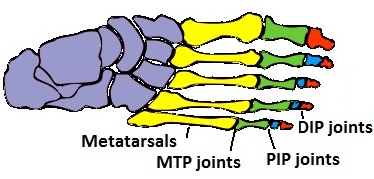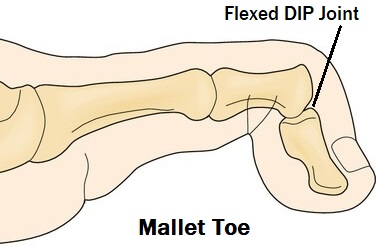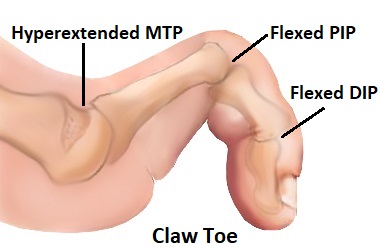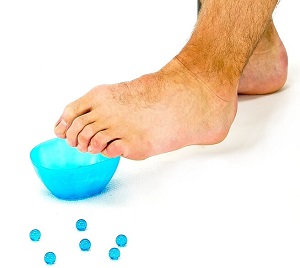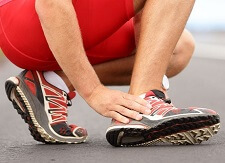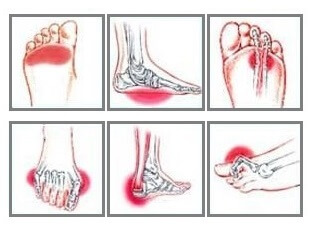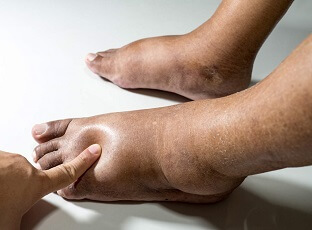- Home
- Diagnosis Guide
- Toe Pain
- Mallet Toe
Mallet Toe
Written By: Chloe Wilson BSc(Hons) Physiotherapy
Reviewed By: FPE Medical Review Board
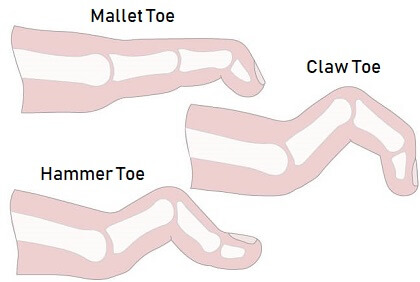
Mallet Toe, Hammer Toe & Claw Toe are similar conditions, all caused by deformity of the toe joints.
Toe deformities usually develop slowly from wearing poor fitting shoes, but can also be due to muscle or nerve damage.
Muscle imbalance causes the toes to bend into odd positions which can be extremely painful, limiting walking and any activities where you are on your feet.
Hammertoe and Mallet Toe are caused by a problem in one joint whereas in Claw Toe, all three toe joints are affected.
Toe deformities become more common with aging and affect approximately 10-15% of the population. Women are five times more likely to suffer from hammer, claw or mallet toe than men. They may also lead to other problems such as corns or calluses and long term stiffness in the toes.
What Causes Toe Deformities?
There are two joints in the big toe and three joints in the other four toes:
- Metatarsophalangeal Joint (MTP): where the toes start, like your knuckles on your hand
- Proximal Interphalangeal Joint (PIP): the middle toe joint
- Distal Interphalangeal Joint (DIP): the joints closest to the end of the toes
Muscles and tendons attach onto these foot bones and control the position and function of the toes.
If tightness or weakness develops in the tendons, most commonly extensor digitorum longus (EDL), flexor digitorum longus (FDL) or the intrinsics, the joints are pulled into the wrong position resulting in either Claw, Hammertoe or Mallet toe.
How Are They Different?
Let's look at how these three toe deformities differ from each other:
1. Mallet Toe
Mallet toe only affects one of the toe joints and occurs when the end toe joint (DIP) flexes on a permanent basis.
This prevents the toe from being able to straighten and causes the tip of the toe to point downwards.
Mallet toe problems most commonly occur in the second toe.
2. Hammer Toe
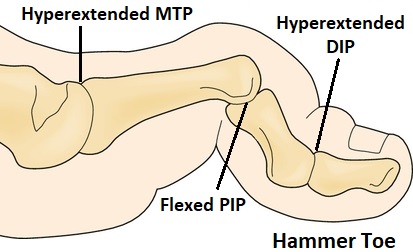
Hammertoe is caused when the middle joint (PIP) bends down towards the floor into flexion.
To compensate, the joints above and below (MTP, DIP) hyperextend i.e. bend backwards. The result of this combination is that the middle part of the toe lifts up.
Hammer toe is the most common deformity of the lesser toes i.e. not the big toe. It tends to only affect one toe, most commonly the second. Find Out More >
3. Claw Toe
Claw Toe occurs when the final two toe joints (DIP, PIP) flex to curl the toe downwards.
To compensate, the first toe joint (MTP) hyperextends so the toe bends up where it meets the foot.
Claw Toe problems often affects the four outer toes at the same time. Find Out More >
Here we will concentrate on Mallet Toe.
Causes Of Mallet Toe
There are a number of things that can cause Mallet Toes to develop:
- Footwear: Mallet toes are most commonly caused by wearing high heels or ill-fitting shoes that are too tight e.g. narrow toebox. If shoes like this are worn for long periods, the foot is held in a slightly bent position and gradually over time, the muscles tighten and shorten. If this continues for long enough, then the foot muscles become so tight that even when shoes are removed, the toe is still held in the bent position
- Toe Length: Another common cause is Morton’s Toe, where the second toe is longer than the big toe. In this case, the second toe is commonly squashed into a shoe into an unnaturally bent position, typically resulting in hammer toe or mallet toe
- Poor Blood Supply: conditions that affect the blood and oxygen flow to the feet e.g. peripheral vascular disease can lead to toe deformities
- Foot Biomechanics: Altered foot position e.g. bunions or flat feet pushes the toe joints out of place which can lead to hammer toe, mallet toe or claw toe
- Injury: Previous foot injuries e.g. stress fractures can affect toe joint position
- Neural Problem: problems in the central or peripheral nervous system e.g. nerve damage, brain damage or spinal cord injury
- Joint Disease: e.g. rheumatoid arthritis can lead to hammer toe, mallet toe or claw toe
- Peripheral Neuropathy: Damage to the nerves in the foot e.g. from Diabetes can shift the toe joints out of place
- Genetics: there is a strong genetic link here and mallet toe is often hereditary
Mallet Toe Symptoms
Typical symptoms of Mallet Toe include:
- Abnormal Toe Position: The most obvious symptom of mallet toe is the abnormal toe positions where the tip of the toe bends downwards while the rest of the toe is straight
- Toe Pain: the abnormal foot position leads to excessive friction on the toe as it rubs against any footwear which can be extremely painful
- Corns & Calluses: repeated friction can result in the formation of a foot corn or callus on top of the toes. Find out more in the foot corns section
- Toe Stiffness: the toe joints become increasingly stiff. In the early stages, the toes can usually be straightened out passively using your hands, but if allowed to progress, the toe stiffness may be permanent
Mallet Toe Treatment
In the early stages, the deformities from mallet toe can be corrected. But if treatment for toe problems is delayed too long, permanent stiffness can ensue which can only be corrected by surgery. The most effective treatment options for toe deformities are:
1. Toe Exercises
Mallet toe exercises to strengthen and stretch the muscles can be really helpful.
Simple foot and toe exercises, things like trying to pick marbles up with your feet or scrunching up a towel underneath your foot can work well for correcting toe deformities as they help to strengthen and stretch the foot. Visit the foot exercises section to find out more.
2. Orthotics
Anyone suffering from Claw, Hammer or Mallet Toes should see an orthotist or podiatrist. Orthotic inserts in your shoes can be used to help relieve pressure on the toes from the joint deformity, thus reducing toe pain and inflammation. The most popular are:
- Mallet Toe Splints: which wrap round the toe and midfoot and help keep the top straight. Find Out More >
- Single Toe Splints: which wrap round a single toe to help straighten it Find Out More >
- Buddy Splints: Strap the affected toe to the neighbouring toe to hold it straight. Find Out More >

3. Good Fitting Footwear
Footwear is key when treating toe deformities. Shoes with a wide toe box will be more comfortable and will reduce the tension on the muscles and friction on the toes.
If you are suffering from claw toe, hammer toe or mallet toe, avoid high heels as they push your feet forwards to the front of the shoes. This increases the pressure on the toes, forcing them to bend more than usual. Shoes should ideally be half an inch longer than your longest toe.
4. Toe Stretchers

Toe stretchers can be used to re-align and stretch your toes. This in turn helps to correct any muscle imbalance and tendon shortening.
One of the most common types used are toe stretchers such as the yoga toe. They really can make a massive difference.
You can find out more about how they work and read user reviews in the Toe Stretchers section.
5. Injections
Steroid injections can help to reduce pain and inflammation associated with mallet toe. They should not be done in isolation but combined with other treatments for long term benefit.
6. Surgery
In some cases, toe deformities from mallet toe can get severe enough that foot surgery may be recommended.
The type of surgery required will depend on how limited the toe joint movement is. Foot surgery may be done on the tendons to length them or small fragments of bone may need to be removed to allow for realignment.
7. Chiropody
A chiropodist can remove calluses or corns, areas of hard skin that have formed with hammer, claw or mallet toes to make the foot more comfortable
Mallet Toe Summary
Mallet toe, hammer toe and claw toe are common toe deformities. They are subtly different from each other and are distinguished by which toe joints are flexed and which are hyperextended.
Toe deformities are most typically caused by long-term wearing of tight, narrow shoes. They can also develop after foot injuries or joint, nerve or muscle problems. Mallet toe treatment often involves a combination of exercises, orthotics and changing footwear.
There are a number of other conditions that can cause problems aside from hammer, claw and mallet toe - visit the toe pain section to find out more.
Alternatively if you want help working out what is wrong and what you can do about it, visit the foot pain diagnosis section.
You may also be interested in the following articles:
- Pain On Top Of Foot
- Foot Arch Pain
- Nerve Pain In The Foot
- Foot & Ankle Stretches
- Foot Numbness
- Foot Lumps & Bumps
Related Articles
Page Last Updated: 7th November, 2024
Next Review Due: 7th November, 2026
